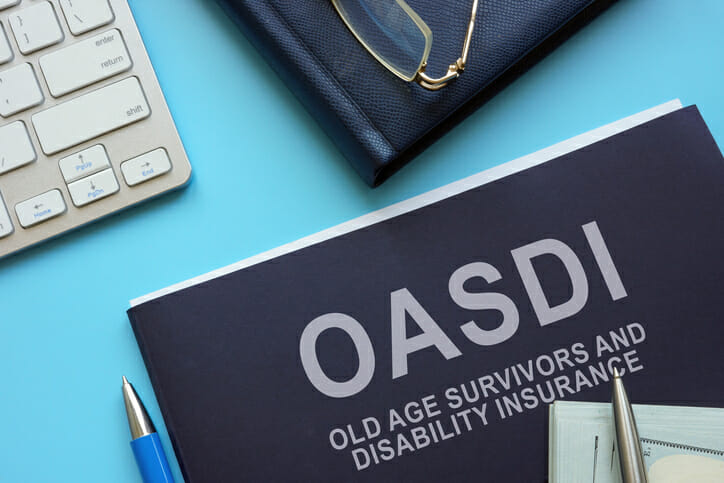If you’ve glanced at your pay stub or W-2 from your employer, you may be dismayed at the rundown of tax items dinging your take-home pay. The Old Age, Survivors, and Disability Insurance program (OASDI) is one such tax. Fortunately, the government intends payment of OASDI taxes to mean retirement income for you in the future. This tax supports retirees, their families, and Americans who are disabled. The 2026 rate for employees and employers remains 6.2%. Here are the details on paying it, acquiring an exemption and how it fits into your retirement plan.
Consider working with a financial advisor as you assess your tax plan. Connect with an advisor for free.
What Is OASDI Tax on My Paycheck?
The Old Age, Survivors and Disability Insurance (OASDI) tax funds the Social Security system in the United States. As the name implies, OASDI payments go to those who are retired, disabled or have a spouse who earned Social Security benefits pass away.
The OASDI tax rate has been 12.4% since 1990. Tax law divides the responsibility to pay OASDI between employer and employee. As a result, the OASDI tax on your paycheck is 6.2%, and your employer pays the other 6.2%. Self-employed workers pay the entire OASDI tax but can deduct half when they file taxes.
How Does the OASDI Tax Work?
OASDI taxes impose a 6.2% rate on employees and 12.4% on self-employed workers. Paying this tax simulates saving for retirement while funding the federal government’s Social Security program, which supports US citizens who are retired, disabled, or a surviving spouse of someone who paid OASDI taxes.
The government can change the tax rate with new legislation. But the current rate of 12.4% has lasted for over 30 years. Fortunately, the tax applies to a limited amount of income. The maximum income on which you’ll pay OASDI taxes for the 2026 tax year is $184,500 (up from $176,100 in 2025).
What Is OASDI Tax If I’m Self-Employed?

The OASDI tax for self-employed workers is 12.4%. While conventional employees split this tax with their employers, self-employment means footing the entire bill. As a result, self-employed taxpayers must make quarterly OASDI payments of 12.4% of their income.
Fortunately, you can deduct half of OASDI taxes when you file your annual tax return if you’re self-employed. This deduction makes the self-employed rate identical to the typical employee’s rate after filing your annual tax return.
Is the Social Security Tax the Same as the OASDI Tax?
Saying “Social Security tax” to refer to OASDI taxes is essentially correct but glosses over the details. Specifically, the federal government invests 85 cents of each tax dollar in a fund for retired Americans and, if they pass away, their surviving spouses and children. Nearly 15 cents of each dollar go to another fund for Americans with disabilities. The remaining fraction of a penny of each OASDI dollar pays for administrative fees.
Is the OASDI Tax Mandatory?
The OASDI tax is mandatory for nearly all working Americans. Exemptions for the tax are scant, applying only to specific religious organizations, academic workers or researchers without U.S. citizenship or permanent resident status and self-employed individuals earning less than $400 annually.
You can apply for OASDI tax exemption with Form 4029. However, the IRS won’t issue an exemption if you don’t fit one of the definitions described above.
OASDI Taxes for Nonresident U.S. Citizens
Generally, nonresident U.S. citizens must pay OASDI taxes. However, exceptions may apply to nonresidents due to their country of residence. For instance, the U.S. has tax treaties with countries such as Canada and the United Kingdom to prevent Americans from suffering double taxation. That said, treaties vary by country, so it’s best to work with a tax professional to ensure you comply with the tax code.
Furthermore, your line of work may exempt you from OASDI taxes. Specifically, the following visas make nonresident U.S. citizens exempt:
- A-visas, typically for employees of foreign governments.
- D-visas for work conducted outside the U.S. or for crew members of a foreign ship or aircraft with a foreign employer.
- Researchers and academic workers with F-visas, J-visas, M-visas, and Q-visas.
- G-visas for employees working for an international organization.
- Specialty workers with H-visas. For instance, H-2A visas are for temporary agricultural workers.
Does the OASDI Tax Cover Retirement Expenses?

The average Social Security distribution for a retired worker in November 2025 was about $2,013 per month or $24,156 annually. 1 As a result, the OASDI tax isn’t enough to cover retirement expenses. Social Security payments are usually a crucial element of a retiree’s income, but it’s equally vital to rely on your own retirement savings. For example, having a 401(k) or IRA as your primary source of retirement income and OASDI tax to supplement your budget is more realistic than living on Social Security alone.
Likewise, retiring with a disability at retirement age or earlier doesn’t mean your OASDI benefit will cover all your living expenses. Therefore, whether you retire as intended or leave the workforce due to a disability, it’s critical to have your own savings to rely on apart from Social Security.
Bottom Line
The OASDI tax on your paycheck funds Social Security benefits for millions of Americans. Most workers pay OASDI taxes, and you’ll pay more (at least up front) if you’re self-employed. The exemptions from the tax are few and far between because the system works best when most working Americans pay into the system. Ideally, you’ll also receive Social Security in retirement but your monthly payment will likely not cover all of your expenses. Therefore, saving for retirement in your own account is still necessary for most pre-retirees.
Tips for OASDI Taxes
- Keeping up with taxes and retirement savings can be challenging, especially if you’re self-employed. Fortunately, a financial advisor can help straighten out your situation and create a detailed retirement plan. Finding a financial advisor doesn’t have to be hard. SmartAsset’s free tool matches you with vetted financial advisors who serve your area, and you can have a free introductory call with your advisor matches to decide which one you feel is right for you. If you’re ready to find an advisor who can help you achieve your financial goals, get started now.
- Unfortunately, retirement doesn’t mean no more taxes. In fact, your Social Security checks may be taxable depending on your income level.
Photo credit: ©iStock/designer491, ©iStock/adamkaz, ©iStock/designer491
Article Sources
All articles are reviewed and updated by SmartAsset’s fact-checkers for accuracy. Visit our Editorial Policy for more details on our overall journalistic standards.
- “Monthly Statistical Snapshot, November 2025.” SSA.Gov, Dec. 2025, https://www.ssa.gov/policy/docs/quickfacts/stat_snapshot/.
